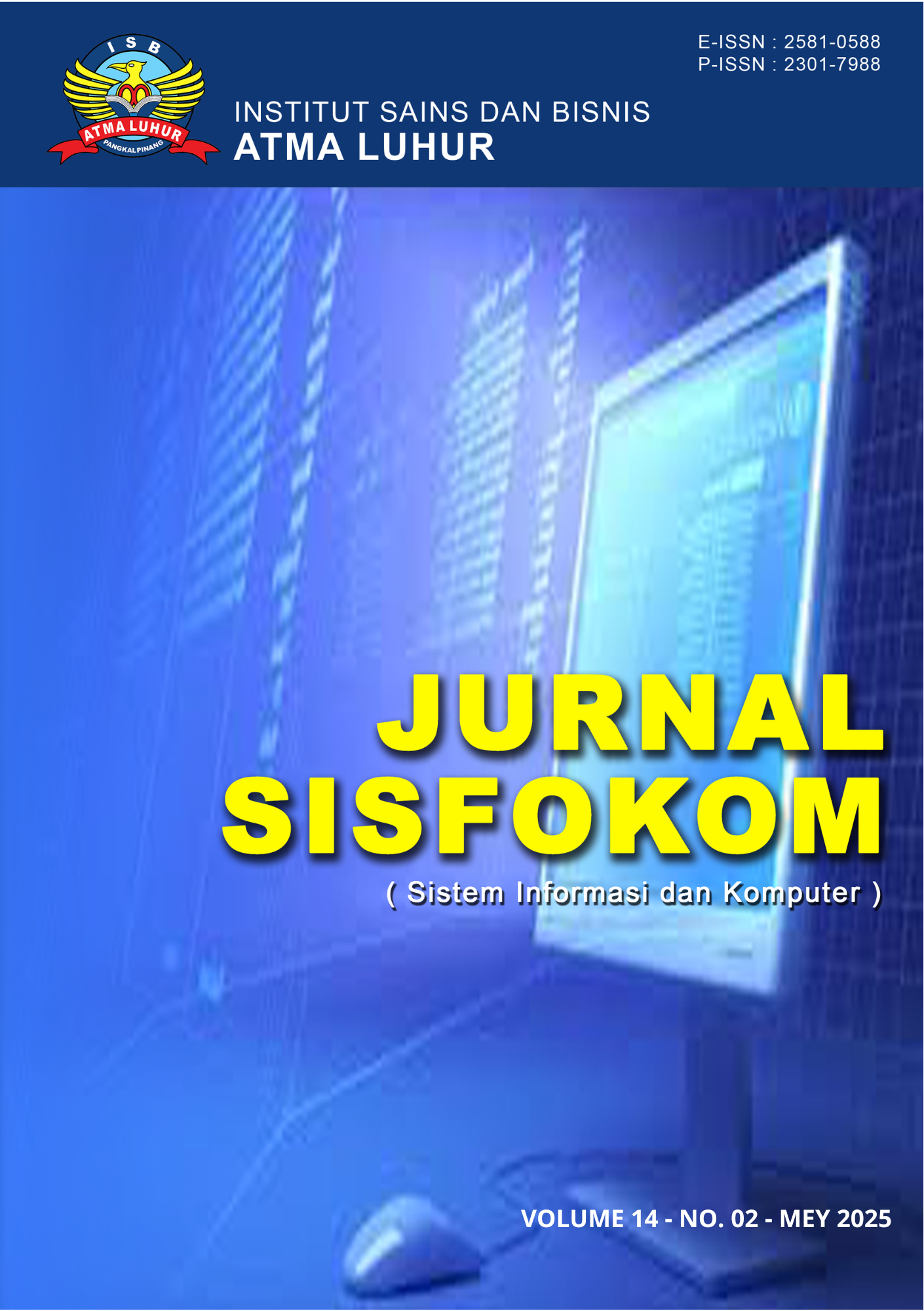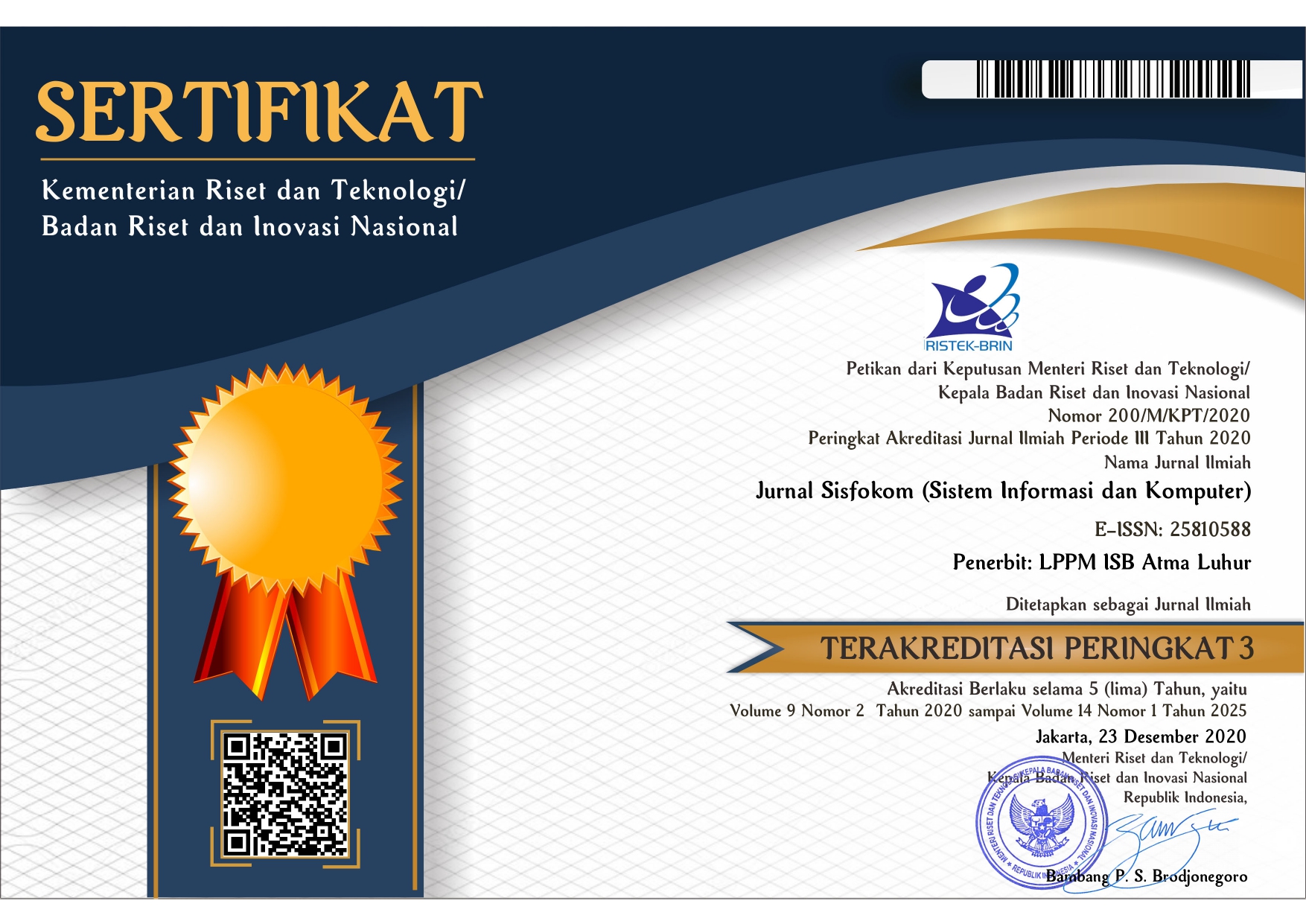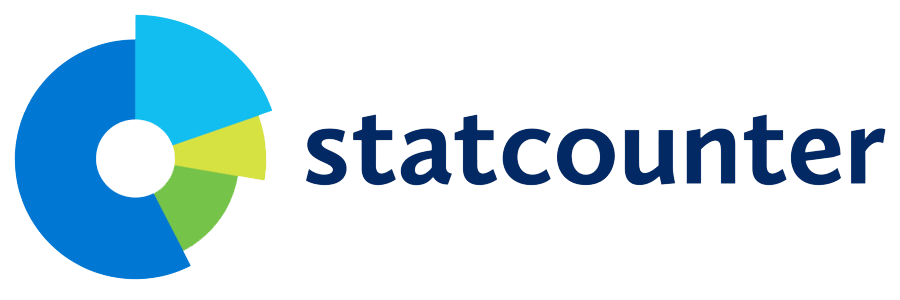SIMPELMAS: An Integrated Information System for Research and Community Service Using a Prototype Development Approach
DOI:
https://doi.org/10.32736/sisfokom.v14i2.2339Keywords:
Management Information System, Research Community Service, Data Integration, Higher Education, Digital TransformationAbstract
The Institute for Research and Community Service (LPPM) plays a strategic role in coordinating academic research and community engagement activities. However, fragmented data management continues to hinder performance evaluations and strategic decision-making in many universities. This study aims to develop SIMPELMAS (Research and Community Service Management Information System), an integrated platform designed to streamline the management of human resources, research, and community service data. Using a prototype-based development methodology, SIMPELMAS was implemented and tested in Universitas Muria Kudus. The system achieved high success rates in various aspects: over 95% in functionality, 99–100% in security, and 80–85% in user satisfaction. Key features such as proposal submission, fund monitoring, and final reporting functioned optimally. Integration testing confirmed effective data synchronization, while user feedback highlighted the need for improvements in user experience, particularly for students and new users. This study contributes to the digital transformation of higher education by providing a replicable model for academic information systems that support real-time monitoring, transparency, and data-driven governance. While the system has met key eligibility standards, further enhancements in user interface and mobile responsiveness are recommended to ensure broader usability and adoption.References
S. Sarah, S. Sugiarto, and M. Ahmad, “Digital-Based Academic Management Service : A Case Study in Open University,” Jurnal Paedagogy, vol. 10, p. 910, Jul. 2023, doi: 10.33394/jp.v10i3.8374.
C. McInnis, “The impact of technology on faculty performance and its evaluation,” New Directions for Institutional Research, vol. 2002, pp. 53–62, Jun. 2002, doi: 10.1002/ir.46.
M. I. Ekarini, A. Rahayu, D. Disman, and L. A. Wibowo, “Implementation of Digital Transformation and Government Enterprise Architecture in Improving the Performance of Integrated Social Services,” Jurnal Manajemen Pelayanan Publik, vol. 8, no. 2, pp. 742–761, 2024, doi: 10.24198/jmpp.v8i2.54095.
C. Jim and H.-C. Chang, “The current state of data governance in higher education,” vol. 55, pp. 198–206, Feb. 2018, doi: 10.1002/pra2.2018.14505501022.
C. Jim and H.-C. Chang, “The current state of data governance in higher education,” vol. 55, pp. 198–206, Feb. 2018, doi: 10.1002/pra2.2018.14505501022.
D. Zustiyantoro, “The Proceedings of the English Language Teaching, Literature, and Translation (ELTLT) Data Integration and Lecturer Expertise: Its Relevance to the Academic Reputation of the Faculty of Languages and Arts UNNES,” vol. 11, no. 1, pp. 2580–7528, 2022.
Daryono, “The Trends in Educational Management Research and Its Implications to Higher Education: A Bibliometric Analysis,” Ilomata International Journal of Social Science, vol. 4, pp. 350–365, Jul. 2023, doi: 10.52728/ijss.v4i3.776.
M. I. Ekarini, A. Rahayu, D. Disman, and L. A. Wibowo, “Implementation of Digital Transformation and Government Enterprise Architecture in Improving the Performance of Integrated Social Services,” Jurnal Manajemen Pelayanan Publik, vol. 8, no. 2, pp. 742–761, 2024, doi: 10.24198/jmpp.v8i2.54095.
J. Sithumini, A. Sanjuka, P. Ranawaka, H. Hasaranga, T. Samarakkody, and G. Pathirana, Systematic Review: The Role of Data Analytics in Enhancing Academic Performance Classroom interaction, Learning Analytics in Higher Education. 2024.
Y. Widodo, R. Korwa, and R. Nuraini, “Artificial Intelligence Based Decision Support System for Education Management in Higher Education,” al-fikrah: Jurnal Manajemen Pendidikan, vol. 11, p. 352, Dec. 2023, doi: 10.31958/jaf.v11i2.12120.
X. Wei, “Research on the Optimization of University Performance Management Information System in the Big Data Era,” 2021, pp. 628–635. doi: 10.1007/978-3-030-69999-4_86.
A.-R. Bologa, R. Bologa, G. Sabau, and M. Muntean, “Integrated information systems in higher education,” WSEAS Transactions on Computers, vol. 7, May 2008.
X. Zhu, S. Ge, and N. Wang, “Digital transformation: A systematic literature review,” Computers & Industrial Engineering, vol. 162, p. 107774, 2021, doi: https://doi.org/10.1016/j.cie.2021.107774.
I. Solin, R. Nugrahani, and N. Kusumoretno, “A REVIEW AND CASE STUDIES OF INTEGRATED MANAGEMENT SYSTEM IMPLEMENTATION IN THE ELECTRIC POWER TRANSMISSION BUSINESS,” Jurnal Kelola Jurnal Ilmu Sosial, vol. 6, p. 50, Sep. 2023, doi: 10.54783/jk.v6i2.731.
B. George and O. Wooden, “Managing the Strategic Transformation of Higher Education through Artificial Intelligence,” Administrative Sciences, vol. 13, no. 9, 2023, doi: 10.3390/admsci13090196.
D. Lee, S. Kim, and S. H. Cha, “Evaluating the effectiveness of research centers and institutes in universities: Disciplines and life cycle stages,” KEDI Journal of Educational Policy, vol. 11, no. 1, pp. 119–137, 2014.
H. Taherdoost, “Data Collection Methods and Tools for Research; A Step-by-Step Guide to Choose Data Collection Technique for Academic and Business Research Projects Hamed Taherdoost. Data Collection Methods and Tools for Research; A Step-by-Step Guide to Choose Data Coll,” International Journal of Academic Research in Management (IJARM), vol. 2021, no. 1, pp. 10–38, 2021.
N. Carter, D. Bryant-Lukosius, A. DiCenso, J. Blythe, and A. J. Neville, “The use of triangulation in qualitative research,” Oncology nursing forum, vol. 41, no. 5, p. 545—547, Sep. 2014, doi: 10.1188/14.onf.545-547.
R. K. Yin, Case Study Research and Applications: Design and Methods. SAGE Publications, 2017.
M. Saunders, P. Lewis, and A. Thornhill, Research Methods for Business Students. Financial Times/Prentice Hall, 2007.
D. Mourtzis, J. Angelopoulos, and N. Panopoulos, “A Literature Review of the Challenges and Opportunities of the Transition from Industry 4.0 to Society 5.0,” 2022. doi: 10.3390/en15176276.
G. Bowen, “Document Analysis as a Qualitative Research Method,” Qualitative Research Journal, vol. 9, pp. 27–40, Aug. 2009, doi: 10.3316/QRJ0902027.
R. S. Pressman, Software Engineering: A Practitioner’s Approach. in McGraw-Hill higher education. Boston, 2005.
F. Davis and P. Warshaw, “User Acceptance of Computer Technology: A Comparison of Two Theoretical Models,” Management Science, vol. 35, pp. 982–1003, Aug. 1989, doi: 10.1287/mnsc.35.8.982.
J. S. Valacich and J. F. George, Modern Systems Analysis and Design. Pearson Education, Incorporated, 2024.
K. C. Laudon and C. G. Traver, E-Commerce 2023: Business, Technology, Society, Global Edition. Pearson Education, 2023.
J. Lewis and J. Sauro, “USABILITY AND USER EXPERIENCE: DESIGN AND EVALUATION,” 2021, pp. 972–1015. doi: 10.1002/9781119636113.ch38.
S. Davis, Software Engineering: The Year 11 Course. Parramatta Education Centre, 2024.
R. Stair and G. Reynolds, Principles of Information Systems. Cengage Learning, 2016.
Nirsal et al., MODERN DATABASE MANAGEMENT. 2024.
Downloads
Published
Issue
Section
License

This work is licensed under a Creative Commons Attribution 4.0 International License.
The copyright of the article that accepted for publication shall be assigned to Jurnal Sisfokom (Sistem Informasi dan Komputer) and LPPM ISB Atma Luhur as the publisher of the journal. Copyright includes the right to reproduce and deliver the article in all form and media, including reprints, photographs, microfilms, and any other similar reproductions, as well as translations.
Jurnal Sisfokom (Sistem Informasi dan Komputer), LPPM ISB Atma Luhur, and the Editors make every effort to ensure that no wrong or misleading data, opinions or statements be published in the journal. In any way, the contents of the articles and advertisements published in Jurnal Sisfokom (Sistem Informasi dan Komputer) are the sole and exclusive responsibility of their respective authors.
Jurnal Sisfokom (Sistem Informasi dan Komputer) has full publishing rights to the published articles. Authors are allowed to distribute articles that have been published by sharing the link or DOI of the article. Authors are allowed to use their articles for legal purposes deemed necessary without the written permission of the journal with the initial publication notification from the Jurnal Sisfokom (Sistem Informasi dan Komputer).
The Copyright Transfer Form can be downloaded [Copyright Transfer Form Jurnal Sisfokom (Sistem Informasi dan Komputer).
This agreement is to be signed by at least one of the authors who have obtained the assent of the co-author(s). After submission of this agreement signed by the corresponding author, changes of authorship or in the order of the authors listed will not be accepted. The copyright form should be signed originally, and send it to the Editorial in the form of scanned document to sisfokom@atmaluhur.ac.id.









